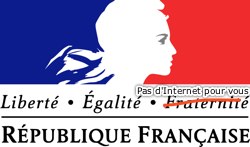A Copyright Reform Glossary.
- copyright protection
- See: copyright restriction
- copyright restriction
- A state-granted monopoly power used to prevent people from sharing copies of things they already have, and from making derivative works or remixes based on their copies. Sometimes called copyright protection.
- rights owner
- Someone with a government-granted monopoly on duplication of a particular work.
- piracy
- Making copies from a source you already have, without waiting for a third party’s permission. Also: forcibly boarding a ship on the high seas, threatening or taking hostage its crew, and stealing its cargo.
- fair use
- What all uses once were. Today, refers only to uses that do not interfere with monopoly-based business models.
- file-sharing
- See: music-sharing
- music-sharing
- Sharing music, as humans have done throughout history. Sometimes called file-sharing, when the music is shared via a computer network.
- plagiarism
- Claiming credit for someone else’s work. This is unrelated to copying and making derivative works.
- intellectual property
- A catch-all category that lumps together trademarks (a legal device for preventing identity confusion) with copyrights (monopoly on the distribution of culture) and patents (monopoly on the use of ideas). Since trademark law actually has much more to do with anti-fraud laws, it might be better to refer to that category as intellectual integrity law, to copyrights and patents as intellectual monopoly law, and avoid the term intellectual property altogether.
- theft or stealing
- The act of taking something in such a way that the original possessor loses it. Contrast with copying, in which a new thing is created that is similar to, or the same as, a thing that the original possessor continues to have afterwards.
- censorship
- Preventing people from sharing information. See also: copyright restriction
- copyfraud
- Making false claims of copyright ownership and/or false allegations of copyright infringement, whether malicious or accidental. Copyfraud often results from attempts to use automated systems to detect copyrighted material online. Such automated systems frequently misidentify content, or misunderstand the distribution rights associated with content; furthermore, some organizations will even manually file incorrect or occasionally deliberately fraudulent infringement claims of infringement. (Google’s copyright takedown request report, this EFF article, and this TorrentFreak article have more details about these phenomena). All of these causes can lead to copyfraud: a video or song or other material gets pulled offline, or someone receives a legal notice of infringement, and the burden is now on the artist or uploader to to prove that there was no infringement.
- public domain
- A special term used to describe the absence of statutory restrictions that chain copies of a given work to one party, who has (with certain limitations) control over the distribution and re-use of those copies. The public domain is sometimes talked about as though it were some kind of holding pen for works that have reached a certain age; we prefer to think of it as the normal home of all works except those which have been sentenced to a more restricted life under monopoly control. Before such monopoly restrictions became default, no term was needed to describe their absence.
- “fall into” the public domain or “lapse into” the public domain
- To be elevated to the public domain. This refers to the moment when default statutory monopoly restrictions expire for a given work.
- free license
-
A “free license” is a copyright license that guarantees everyone permanent rights to use a work, to study and learn from it, to share it with anyone else, to display or perform it, and to distribute derivative works related to it, all without requiring permission first. (Note that these freedoms do not mean allowing people to take credit for work that’s not theirs: that’s just misattribution or fraud, and the best protection against it is to have legitimate, correctly labeled copies circulating widely.)
Two of the most widely used free licenses are the Creative Commons Attribution (CC-BY) and Attribution-ShareAlike (CC-BY-SA) licenses. Note that licenses that restrict commercial use, or that require permission for derivative works, are not free licenses.
The software field also has an unusually rich and varied set of free licenses, due to the long history of legal activism to promote sharing and freedom there; see the Free Software Foundation and Open Source Initiative web sites for more about those licenses.
For a more formal explanation of these freedoms, and why they are the test that we and others use, see Freedom Defined. That site also has a more complete list of freedom-respecting licenses.
Suggestions for further glossary terms welcome! Please contact us, or leave suggestions as comments. We’ll review and incorporate the best ones.


